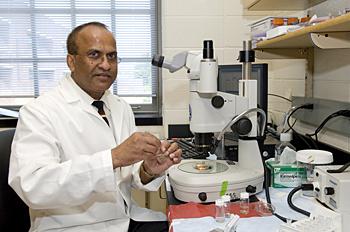Naik received the award at the Experimental Biology Meeting in San Diego during ASIOA's banquet, April 7.
“This award means a lot to me. I am very excited and happy.
I have received several awards from scientific societies in America, however, this is the first from the scientific community in my country. It truly attests to my achievements and the respect fellow scientists have for my work. The award also means that UD's faculty is being recognized by the national and international scientific community,” Naik said.
The Indian Science Congress has invited him to chair a session and to deliver a lecture at its annual meeting in India this year, Naik said.
“Such awards will help put UD on the global map. In fact, I now receive inquiries from prospective students in India on a daily basis,” he said.
The Mario Toppo Distinguished Scientist Award is given to an established senior scientist of Indian origin who has made outstanding contributions to the sciences.
Naik's research centers on the molecular mechanisms of signal transduction in cardiovascular diseases and cancer, specifically, cell-cell interactions and cell-extracellular matrix interactions. He and his research group, the Laboratory for Cardiovascular and Cancer Biology, examine the molecular mechanisms involved in the regulation of these interactions under physiological and patho-physiological conditions.
He received a doctorate from the University of Bombay in India and did postdoctoral work at Weill Medical College of Cornell University and the College of Medicine at SUNY Upstate Medical University.
ASIOA's mission is to promote fellowship among scientists of Indian origin living in America, to act as a scientific, educational, fraternal and charitable organization and to establish open channels of communication among all scientists.
Article by Barbara Garrison
Photo by Kathy F. Atkinson


